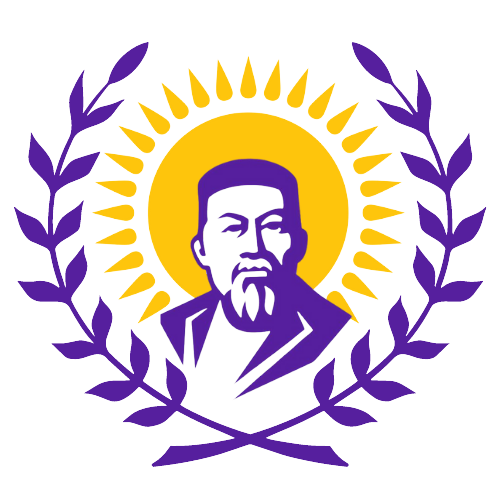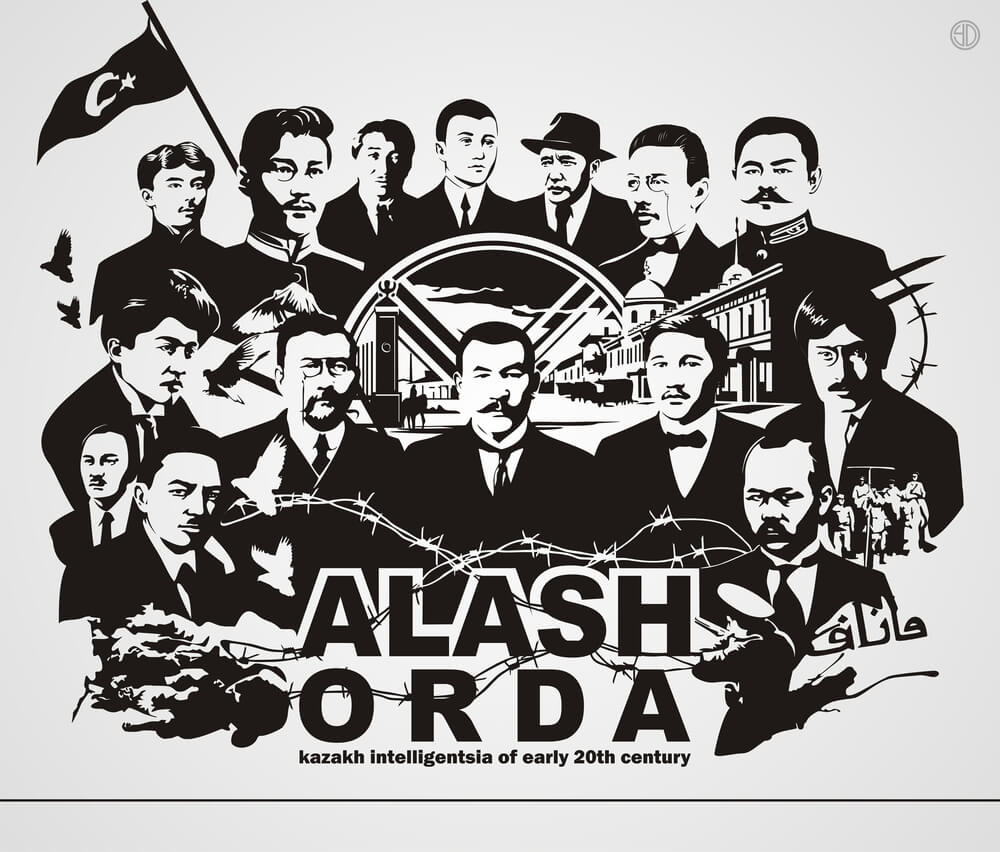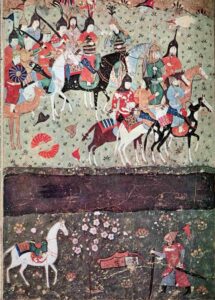The geographical position of Kazakhstan has required it to be constantly politically, economically, and socially intertwined with its large number of neighbouring nations. In the 19th and early 20th centuries, the traditional nomadic Kazakh society faced oppressive Russian colonial encroachment that threatened its independence, national identity and ethnic consciousness. There was a group of Kazakhs who joined the efforts into one political movement – Alash Party – and had made one of the most significant attempts at resistance to Russian imperial rule. Members of this party would fight for their country in the intellectual debates and political fields of the early 20th century guided by an arduous but very necessary challenge of achieving modernization and progress. A century later modern Kazakhs need to commemorate the legacy of the Alash Orda intelligentsia and their visions of Kazakhstan and Qazaqtyq (or ‘Kazakhness’). It is particularly important in current times when Kazakh state is rebuilding its national identity while preserving commitment to modernization.

Tsarist colonization and disruption of the nomadic life
By the late 19th century, the expanding Russian Empire under Tsar Alexander II had conquered a majority of Central Asia and named this territory ‘Russian Turkestan’. The Russian system of rule imposed on Kazakhs during this period was perceived as an attempt to alter the traditional social structures of nomadic society.1 Nomadism, which was a key defining element of the Kazakh peoples for centuries, was facing an oppressive force. Russian seizures of Kazakh grazing lands in combination with large migrations of Russian and Ukrainian peasants into these territories were greatly undermining the traditional Kazakh way of life. By 1897, 16 percent of the population of the Northern oblasts in the Steppe region was Russian.2 The disruption of the nomadic lifestyle and gradual colonization of the lands by the Russian peasants led to significant impoverishment of the native communities.
But not only economic factors caused concern – Tsarist administration in the attempt “to enlighten the nomads” had carried out an extensive Russification of the population through the avenues of education. A group of Kazakh intelligentsia started to worry that this would lead to the eradication of a distinct national identity within their country. But how could nomads move towards modernization without sacrificing much of their own identity? Gulnar Kendirbaeva, a professor at Columbia University, noted that the beginning of the 20th century effectively marked a key turning point in Kazakh history as groups of intellectuals began to realize that it is imperative to change the traditional nomadic lifestyle and move towards sedentarization and modernization in order to preserve ‘Kazakhness’3.
National modernization agenda
By the 1870s, the Steppe had been moved under greater control of the Russian Empire which had moved further into the southern edges of the Central Asia by applying formidable military action. The traditional powers and leadership roles held by Khans and Sultans in Kazakhstan were abolished by the Tsarist government in 1869 when the Steppe was placed under a civil-military administration.4
In this period of political uncertainty, amid Russian conquest of Central Asia, Kazakh intelligentsia got more concerned with a longer-term future. These intellectuals viewed the undeveloped and archaic nature of traditional Kazakh societal structure and lifestyle in comparison with the more developed European powers of the time.5 They were also greatly inspired by their great compatriot, Abai, who in Word Twenty Five of his Book of Words would emphasize the importance of education and the understanding of Western societal and technological advancements for Kazakh society. He stated that “By studying the language and culture of other nations, a person becomes their equal and will not need to make humble requests.”6

The Kazakh intelligentsia sought to find the most adequate methods of reconceptualizing and reshaping Kazakh society to survive against the threats toward national identity and ethnic consciousness posed by the industrializing world and the Tsarist government. Importantly, these intellectuals were committed to this path even despite growing risks threatening their existence. As the Russian empire began to crumble and voices of discontent with Tsarist autocracy revealed themselves during the 1905 revolution, Kazakh intellectuals would begin their political activities in earnest.7 Rallies and demonstrations were organized throughout the Kazakh Steppe criticizing the oppressive Tsarist policies. The intelligentsia leading these movements joined Russian revolutionaries and took seats within the newly formed State Duma with hopes to gain more representation and discuss such issues of sedentarization of the nomads, the role of Islam in Kazakhstan, the preservation of the Kazakh language as well as the necessity of developing Kazakh civilization and culture. Discussions of such topics took place on the pages of the first national newspapers Aiqap and Qazaq in the 1910s.
Intellectual debates and enlightenment
The newspaper Qazaq, whose primary editors were Akhmet Baitursynov, Alikhan Bokeikhanov and Myrzhaqyp Dulatov,was published in Orenburg from 1913 to 1918in the traditional Arabic script of the Kazakh language. The editors of this newspaper would go on to form the Alash Autonomy in 1917 together with a number of other intellectuals. This influential newspaper was distributed to a population of 6 million people throughout the Kazakh Steppe and promoted Kazakh nationalism in defiance of imperial policies. Qazaq was very effective in spreading awareness about the problems of the Kazakh communities that were analysed from an intellectual viewpoint and inspired change and resistance. The editors of Qazaq wrote in the first issue of the paper in 1913 – ‘What if we do not overcome our present fate? Do we fold up our yurts and scatter, destroying our society?”8 In challenging the population to act and adapt to new norms instead of being complacent with the traditional lifestyle, Kazakh intellectuals advocated to preserve and uphold national identity within the Steppe. The proponents of the Alash party as well as other Kazakh intellectuals did not consider the retention of a traditional nomadic lifestyle as necessary to preserve a shared national identity despite its historic centrality to the Kazakhs. Instead, their focus was primarily on the preservation of language in combination with advancements in education and modernization fostering an adequate and sustainable transition towards sedentarization.9
The editors of Qazaq undoubtedly took the issues of educating the nomadic peoples extremely seriously throughout their careers. Mirzhakyp Dulatov would compile a collection of powerful poems in his 1909 book Oiian, Qazaq! (Awaken, Kazakh!). It was addressed to the nomadic Kazakh society in an attempt to rouse the peoples to awaken from their ignorance and unite against colonization and land seizures. Dulatov greatly emphasized the need to settle and adapt to new circumstances in order to survive as a nation and preserve traditions and culture.10 Some of the poems in this book would also serve to educate nomads about the technical advancements of the Western world in an accessible format. The name of this book would then become the slogan of the Alash party in 1917.
Another Kazakh poet and member of Alash Orda, Akhmet Baitursynov also attempted to inspire a meaningful shift in Kazakh mentality and awareness through his 1911 book Massa which urged to develop culture and overcome societal deficiencies. Since the nomadic Kazakh peoples had historically used oral tradition to transmit knowledge, the poem was an accessible and effective format. Kendirbaeva described these publications as ‘political manifestos addressed to the Kazakh people in poetic form’.11
The committed efforts of the intelligentsia to fervently support their peoples in the late 19th century and early 20th centuries was paramount to the rapid enlightenment of Kazakh society which had become more literate and educated and developed a solid base of intellectual elites in the later Soviet period all while maintaining national consciousness in the long term.

Politics and defeat
The editors of the newspaper Qazaq would play a key part in establishing the Alash Orda autonomous movement through their continued involvement in bigger Russian politics aiming to achieve Kazakh independence. By January of 1918, the Alash Orda government was established. It was a progressive and revolutionary entity that enjoyed significant popular support. Alikhan Bokeikhanov was its leader and other members of the intelligentsia took the leading posts in its governing bodies. The capital was established in Semipalatinsk. By the summer of 1918, it looked as though the Alash Orda was beginning to successfully handle its administrative challenges, difficult as they were. The Kazakh leadership could have stabilized its rule if left unchallenged.12 The bigger Russian politics, though, were too treacherous for the young government to survive. As Russian revolution intensified the struggle of political fractures, the Civil War tore through the Kazakh lands causing famines and greatly exacerbating economic issues. The Red Army gradually mounted significant victories against the Alash-supported White Army and the conflict ultimately resulted in a defeat of Bokeikhanov’s government with the formation of the Kirgiz (Kazakh) Autonomous Socialist Soviet Republic on October 4th, 1920.13
Despite the short-lived nature of this independent Kazakh government, it cemented a strong sense of unity and ethnic consciousness for the Kazakh people for the years to come, even as leadership changed under Soviet hegemony. In this sense, the key goals of the extensive educational, cultural, and political initiatives that the Alash party proponents had earnestly pursued were effectively realized. Thanks to their efforts, the concept of ‘Kazakhness’ was saved from the brink of eradication and successfully survived the toughest of hardships under Soviet rule allowing the nation to evolve into what it is today.
- “Kendirbaeva, Gulnar (1999) ‘We are children of Alash…’ The Kazakh intelligentsia at the beginning of the 20th century in search of national identity and prospects of the cultural survival of the Kazakh people, Central Asian Survey, 18:1, 5-36, DOI: 10.1080/02634939995722” ↩
- Rottier, Peter (2003) The Kazakness of sedentarization: Promoting progress as tradition in response to the land problem, Central Asian Survey, 22:1, 67-81, DOI: 10.1080/0263493032000108630 68 ↩
- Kendirbaeva, ‘We are the children of Alash…’, 6 ↩
- Rottier, The Kazakness of sedentarization, 70 ↩
- Kendirbaeva, ‘We are the children of Alash…’ 6 ↩
- Kunanbaev, Abai. (1894). Word Twenty Five. The Book of Words. ↩
- Uyama, Tomohiko. (2015). REPRESSION OF KAZAKH INTELLECTUALS AS A SIGN OF WEAKNESS OF RUSSIAN IMPERIAL RULE: The paradoxical impact of Governor A.N. Troinitskii on the Kazakh national movement. Cahiers Du Monde Russe, 56(4), 681-703. Retrieved June 6, 2020, from www.jstor.org/stable/24772295, 702 ↩
- ‘QurmettiOqushylar’, Qazaq, No 1, 1913. ↩
- Kendirbaeva, ‘We are the children of Alash…’, 17 ↩
- Rottier, The Kazakhness of Sedentarization, 77 ↩
- Kendirbaeva, ‘We are the children of Alash…’, 17 ↩
- Olcott, Martha B., The Kazakhs (Stanford, California: Hoover Institution Press, 1987), 151 ↩
- Ibid., 155 ↩





